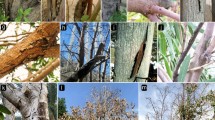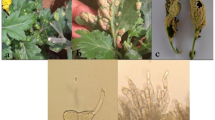Abstract
Melia dubia is an important tree species grown worldwide for its medicinal and timber values. It is widely used in timber and pulp industry and also as an organic pesticide, fertilisers, agro-forestry and herbal formulations. During 2019–2022, a dieback disease in plantations of M. dubia was recorded in Mysore, Mandya, Chamarajanagar, Hassan and Tumkur districts of Karnataka state (India) with disease incidence of 26.25%. The associated pathogen was isolated on PDA medium and its morpho-cultural characteristics were studied. The genomic DNA of the pathogen was isolated, and rDNA was amplified and sequenced using universal primers. Based on the microscopic, morpho-cultural, sequence data and phylogenetic analysis, the pathogen was identified as Diaporthe phaseolorum (Cooke & Ellis) Sacc. Koch’s postulates were performed both in vitro and in vivo and the typical symptoms of dieback disease were recorded on post-inoculated saplings. The dieback disease is responsible for the poor growth of Melia species in the region, and hence, there is an urgent need to manage the disease in plantations using integrated management practices. This is the first report of the occurrence of D. phaseolorum on M. dubia plantations in India.






Similar content being viewed by others
Data availability
The sequences were deposited into GenBank (https://www.ncbi.nlm.nih.gov/genbank), and the accession numbers were provided.
References
Abdullah SK, Al-Saad I, Essa RA (2002) Mycobiota and natural occurrence of sterigmatocysin in herbal drugs in Iraq. Basrah J Sci 20:1–8
Burgess TI, Barber PA, Hardy GES (2005) Botryosphaeria spp. associated with eucalypts in Western Australia, including the description of Fusicoccum macroclavatum sp. nov. Australas Plant Pathol 34:557–567
Carbone I, Kohn LM (1999) A method for designing primer sets for speciation studies in filamentous ascomycetes. Mycologia 91(3):553–556
Charudattan R (2000) Current status of biological control of weeds. Emerging technologies for integrated pest management: concepts, research and implementation. APS, St. Paul, pp 269–288
Cheng Z, Tang W, Xu S, Sun S, Huang B, Yan X, Chen Q, Lin Y (2006) First report of an endophyte (Diaporthe phaseolorum var. sojae) from Kandelia candel. J for Res 19:277–282
Doyle JJ, Doyle JL (1990) Isolation of Plant DNA from fresh tissue. L H Bailey Hortorium 466 Mann Library Building, Cornell University Ithaca, New York, 14853
Fathima SK, Bhat SS, Girish K (2004) Variation in Phomopsis azadirachtae, the incitant of die-back of neem. Indian Phytopath 57(1):30–33
Girish K, Bhat SS (2008) Phomopsis azadirachtae–The Die-Back of Neem Pathogen. Electron J Biotechnol 4(3):112–119
Higley PM, Tachibana H (1987) Physiologic specialization of Diaporthe phaseolorum var. caulivora in soybean. Plant Dis 71:815–817
Janse van Rensburg JC, Lamprecht SC, Auret EE, Groenewald JZ, Crous PW (2006) Characterisation of Phomopsis spp. associated with die-back of rooibos (Aspalathus linearis) in South Africa. Stud Mycol 55:65–74
Koul O, Jain MP, Sharma VK (2000) Growth inhibitory and antifeedant activity of extracts from Melia dubia to Spodoptera lutera and Helicoverpa armigera larvae. Indian J Exp Biol 38:63–68
Kraft JM, Berry JW (1972) Artificial infestation of large field plots with Fusarium solani sp. pisi. Plant Dis 56:398–400
Kumar A, Savita SP, Sharma S, Dobhal S, Rana A, Kumar R (2017) Development of high yielding varieties of Melia dubia Cav. Indian for 143:1203–1206
Lal P (2000) National forest policy and raw material supplies for wood based industries in India. Indian for 126:351–366
Mabberley DJ (1984) A monograph of Melia in Asia and the Pacific. The history of white cedar and Persian lilac. Gard Bull 37:49–64
Marin MV, Wang NY, Coburn JD, Desaeger J, Peres NA (2021) First report of Diaporthe phaseolorum causing stem canker of Hemp (Cannabis sativa). Plant Dis 105:7
Muthu Kumar A, Raja M, Pandey AK (2014) Decline of Melia dubia (Hebbevu) plantations at South Bangalore, Karnataka. Curr Biotica 8(1):82–85
Nagalakshmi MAH, Thangadurai D, Anuradha T, Pullaiah T (2001) Essential oil constituents of Melia dubia, a wild relative of Azadirachta indica growing in the Eastern Ghats of Peninsular India. Flavour Fragr J 16:241–244
Parthiban KT, Seenivasan R (2017) Plantation and Agroforestry Pulpwood Value Chain Approach. Scientific Publishers, New Dehli, India
Rehner SA, Uecker FA (1994) Nuclear ribosomal internal transcribed spacer phylogeny and host diversity in the coelomycete Phomopsis. Can J Bot 72:1666–1674
Santos JM, Vrandečić K, Ćosić J, Duvnjak T, Phillips AJL (2011) Resolving the Diaporthe species occurring on soybean in Croatia. Persoonia 27:9–19
Sateesh MK, Bhat SS, Devaki NS (1997) Phomopsis azadirachtae sp. nov from India. Mycotaxon 65:517–520
Sebastiane FLS, Lacava PT, Fávaro LCL, Rodrigues MBC, Araújo WL (2011) Genetic transformation of Diaporthe phaseolorum, an endophytic fungus found in mangrove forests, mediated by Agrobacterium tumefaciens. Curr Genet 58:21–33
Sergeeva V, Nair NG, Barchia DI, Priest M, Spooner-Hart R (2003) Germination of β conidia of Phomopsis viticola. Australas Plant Pathol 32:105–107
Shah SN, Wani TA, Ram B, Koul M, Awasthi P, Rajput DS, Reddy GR (2016) An efficient protocol for in vitro organogenesis and antioxidant studies in Melia dubia Cav. Afr J Biotechnol 15:768–775
Smith BJ (1997) Detached stem assay to evaluate the severity of stem blight of rabbit eye blueberry (Vacciniuen ashei). Acta Inform 446:457–464
Su YY, Qi YL, Cai L (2012) Induction of sporulation in plant pathogenic fungi. Mycology 3:195–200
Thakur IK, Chauhan KC (2008) Improvement of Morus alba variation, estimates of genetics parameters and correlation in different accession. Indian J for 31:423–428
Udayanga D, Liu X, McKenzie EHC, Chukeatirote E, Bahkali AHA, Hyde KD (2011) The genus Phomopsis: biology, applications, species concepts and names of common phytopathogens. Fungal Divers 50:189–225
Udayanga D, Castlebury LA, Rossman AY, Hyde KD (2014) Species limits in Diaporthe: molecular re-assessment of D. citri, D. cytosporella, D. foeniculina and D. rudis. Pers Mol Phylogeny Evol Fungi 32:83–101
Urbez-Torres JR, Peduto F, Smith RJ, Gubler WD (2013) Phomopsis Dieback: A Grapevine Trunk Disease Caused by Phomopsis viticola in California. Plant Dis 97:1571–1579
White TJ, Bruns TD, Lee SB, Taylor JW (1990) PCR protocols: a guide to methods and applications. Academic Press, London
Yadav D, Sahoo G, Wani AM (2019) Growth performance and variability studies in different half sub families of Melia dubia under greenhouse condition. J Pharmacogn Phytochem 8(2):1008–1011
Funding
The first author (Krupalini V.) would like to thank OBC Cell, University of Mysore, Mysuru, for providing financial assistance (GL-03/49/2021-22).
Author information
Authors and Affiliations
Contributions
The primary author performed experiments and data collection and drafted the paper. The corresponding author have made substantial contributions to conception and design and was involved in revising the manuscript critically for important intellectual content.
Corresponding author
Ethics declarations
Conflict of interest
There is no conflict of interest.
Additional information
Communicated by Nischitha R.
Publisher's Note
Springer Nature remains neutral with regard to jurisdictional claims in published maps and institutional affiliations.
Rights and permissions
Springer Nature or its licensor (e.g. a society or other partner) holds exclusive rights to this article under a publishing agreement with the author(s) or other rightsholder(s); author self-archiving of the accepted manuscript version of this article is solely governed by the terms of such publishing agreement and applicable law.
About this article
Cite this article
Krupalini, V., Janardhana, G.R. Diaporthe phaseolorum causing dieback disease on Melia dubia cav. in Karnataka state (India). Arch Microbiol 206, 92 (2024). https://doi.org/10.1007/s00203-023-03821-4
Received:
Revised:
Accepted:
Published:
DOI: https://doi.org/10.1007/s00203-023-03821-4




